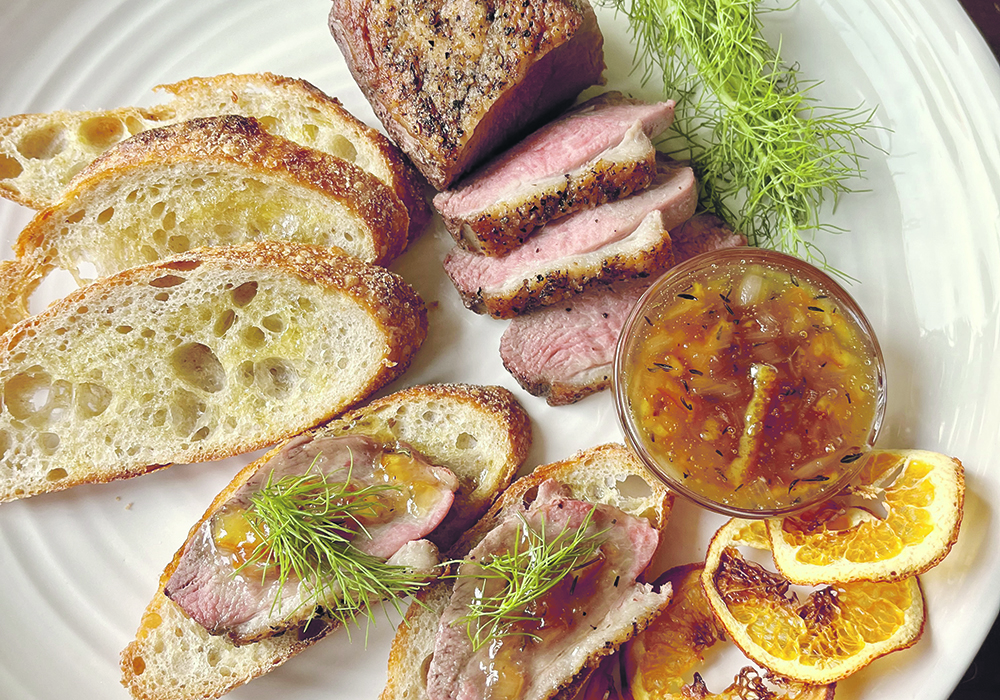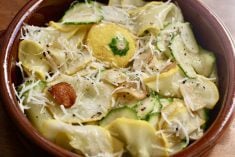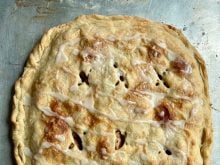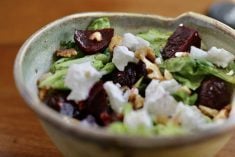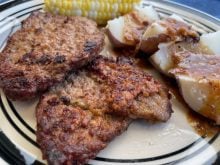Informal entertaining has taken over from the painstaking dinner parties I have always hosted. Now it is usually happy hour and most often it is potluck. There is enough stress in the holiday season already. Make entertaining easy.
Simple cheese and fruit plate
There is no need to make it complicated. A few simple, good quality ingredients are very satisfying. This is a pleasing combination:
- blue cheese, such as Gorgonzola
- whole walnuts, toasted
- honeycomb
- fresh figs
- crackers
Make individual plates or a group sized platter. Serve at room temperature.
Read Also

Alberta cracks down on trucking industry
Alberta transportation industry receives numerous sanctions and suspensions after crackdown investigation resulting from numerous bridge strikes and concerned calls and letters from concerned citizens
Duck breast crostini
- 2 duck breasts
- kosher salt and freshly ground black pepper
- 2 shallots, minced
- 2 sprigs fresh thyme, plus leaves for garnish
- 1 c. orange marmalade 250 mL
- 1 baguette, sliced on the bias into 3/4-inch-thick slices 75 mm
- 4 tbsp. extra-virgin
- olive oil 60 mL
Preheat the oven to 400 F (200 C).
Trim excess fat from along the sides of the duck breasts. Using a sharp knife, score the skin in a crosshatch pattern. Season with salt and pepper and place skin-side down in a cast-iron fry pan. Cook on the stove top over low heat until skin begins to crisp, about 10 to 12 minutes. Turn skin-side up and transfer to the oven to continue cooking, about 10 minutes. If you have a meat thermometer, it should read 54 C for rare, 61 C for medium and 65 C for medium/well done. Remove duck breasts from the skillet and tent with foil to rest for five to 10 minutes.
Meanwhile make the sauce by pouring off excess duck fat from the fry pan and put the pan over medium heat. Add the shallots, thyme sprigs and marmalade. Cook until aromatic and slightly reduced, about four minutes. Discard sprigs.
Brush baguette slices with oil and bake until light brown, four to five minutes.
To assemble, slice duck breast on the bias into 1/4-inch-thick (60 mm) slices. Place a duck slice on a toasted slice of baguette. Drizzle a spoonful of sauce on top. Garnish with a few thyme leaves and serve. It is easier to cut thin slices of duck breast if you place it skin side down.
Caviar
There is nothing more festive than serving caviar. Acadian Sturgeon and Caviar from St. John, N.B., is arguably the best on the market, and it ships right across the country.
The caviar arrives well packed in ice and is as fresh as you will find. They will only ship to street addresses and not to post office boxes. I received it in excellent condition in Swift Current, Sask.
Keep caviar in the coldest spot in your refrigerator and once opened eat within two weeks.
Find the company online at www.acadian-sturgeon.com to place an order.
Simple is best with caviar. It pairs well with nice crunchy, artisanal potato chips. Be sure to serve with a non-metallic spoon. Serve with icy cold vodka, sake or a good quality sparkling wine or champagne.
Butter and herb baked oysters
Cooked oysters may be frozen. I cannot believe how amazing they were after reheating. Take them directly from the freezer and flash bake at 425 F (220 C) for six minutes. They are just like fresh. Make these in advance and reheat just before serving.
Buy fresh oysters from a trusted source. Look for live oysters with shells that are tightly clamped shut or close when you tap them. They should smell like the ocean but not unpleasant. If an oyster shell is open or broken and does not close tight when handled, it should be discarded.
Lay the oyster flat on the countertop and hold it in place with a kitchen towel. Insert the tip of the oyster knife into the hinge at the back of the oyster and gently twist the edge of the knife to pry it open. Carefully cut the muscle away from the shell by sliding the knife horizontally along the inside top of the shell. You may want to use a cut-resistant glove on the hand you are holding the oyster with.
- 2 c. rock salt or uncooked rice, for lining the pan 500 mL
- 1 dozen fresh oysters
- 8 tbsp. salted butter, softened, divided 125 mL
- 3/4 c. panko bread crumbs 200 mL
- 2 tbsp. finely chopped
- chives 30 mL
- 1 tsp. finely grated
- lemon zest 5 mL
- 1 tbsp. lemon juice 15 mL
- finely chopped fresh parsley, for garnish
- lemon wedges, for serving
Position a rack in the centre of the oven and heat to 425 F (220 C). Add a layer of rock salt to a rimmed baking sheet or substitute dry, uncooked rice. This will keep the oyster shells from wobbling.
Scrub the oyster shells with a stiff brush under cold running water to clean.
Shuck oysters and discard the top shells and arrange them in the bottom shell with their liquid in the prepared baking pan.
In a medium skillet over medium heat, melt four tablespoons (60 mL) of butter. Add panko crumbs and cook, stirring, until crumbs are lightly browned. Remove from heat and set aside.
In a bowl, combine remaining four tablespoons (60 mL) of softened butter with the chives, lemon zest and lemon juice.
Top each oyster with a scant teaspoon (5 mL) of the butter-chive mixture and then sprinkle each with buttered panko crumbs.
Bake the oysters until they are cooked through and the topping is golden brown, eight to 10 minutes.
Sprinkle with fresh chopped parsley and serve with lemon wedges.
Cheesy gougeres with smoked salmon
The gougeres may be made ahead and frozen. Reheat and crisp them in a 350 F (180 C) oven for four or five minutes before adding toppings and serving.
- 1/4 c. + 2 tbsp. water 90 mL
- 1/4 c. + 2 tbsp. milk 90 mL
- 1/4 c.+ 2 tbsp. butter 90 mL
- 1/2 tsp. sugar 2 mL
- 1/2 tsp. salt 2 mL
- 2/3 c. all-purpose flour 150 mL
- 1 c. Gruyere cheese, divided 250 mL
- 3 large eggs
Add water, milk, butter, sugar and salt to a medium sized saucepan. Bring to a boil. Then add flour all at once. Beat with a wooden spoon or hand mixer on low until it is very smooth.
Beat in eggs one at a time until smooth. Make sure the mixture is smooth before adding next egg. Beat dough until smooth and shiny. Stir in 3/4 cup of grated Gruyere.
Pipe small rounds of batter, about two tablespoons (30 mL) each. Sprinkle gougeres with the remaining grated cheese.
Bake at 375 F (190 C) for 30 minutes. After 30 minutes poke a hole in the bottom of each with the tip of a sharp knife and return to oven for five more minutes with the door slightly ajar. Turn off the oven and let cool in the oven with the door ajar.
When cooled, top each gougere with a smear of whipped softened cream cheese or crème fraiche. Top with a small slice of smoked salmon. Serve immediately.
Sarah Galvin is a home economist, teacher and avid supporter of local food producers. She has been a market vendor, grew up on a farm in southeastern Saskatchewan and is a member of TEAM Resources.


